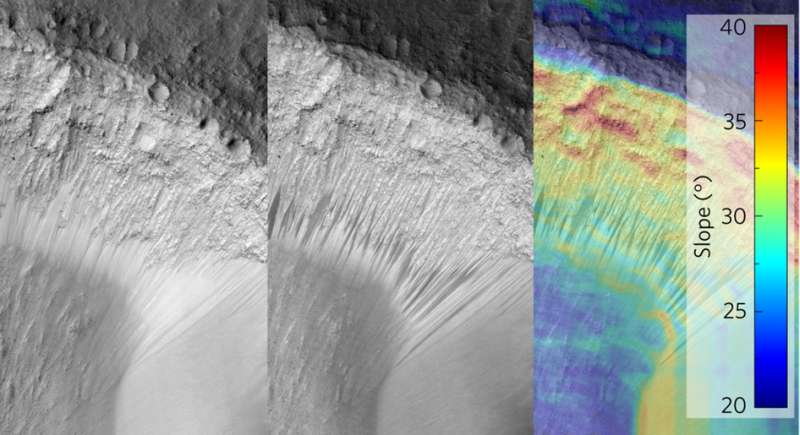March 22, 2017 report
Sand flow theory could explain water-like streaks on Mars

(Phys.org)—A team of researchers from France and the Slovak Republic has proposed a theory to explain the water-like streaks that appear seasonally on the surface of Mars, which do not involve water. In their paper published in the journal Nature Geoscience, the team describes their theory as instances of sand avalanches caused by sunlight with resulting changes to shadowing.
Back in 2011, finger-like marks were first noted on the surface of Mars. After study, it was determined that the streaks changed in a way that appeared to resemble flowing water and that the changes were seasonal—occurring during times when it was hottest. Some scientists suggested that there might be a type of brine just beneath the surface causing the streaks as a result of melting ice, but other studies have suggested the water theory is unlikely because if ice were there, it would likely sublimate rather than melt and evaporate. In this new effort, the researchers suggest the streaks have nothing to do with ice or water but are instead more of an optical illusion.
The researchers suggest the streaks come about due to the heat that is generated during certain times of the year on Mars—it causes the top layer of dirt and sand to heat up while particles underneath remain cool. The difference in temperature causes changes in pressure to very small pockets of gas trapped between the sand particles causing the gas to move upwards. Doing so jostles the sand particles, causing them to slip downhill slightly—like tiny avalanches. The result is recurring slope lineae that originate only on sloping, rocky landscapes. The difference in color is due to the newly fallen particles as they move under shadows cast by boulders or outcrops, mostly during the afternoon as the angle of sunlight would be more pronounced.
More testing will have to be done, of course, before the theory can be proved true, but if it turns out to be the correct explanation, it is likely some in the space field might be disappointed—water just under the surface might have led to the discovery of a form of life, and it might also have proved useful to future astronauts trying to survive on the barren planet.
More information: Frédéric Schmidt et al. Formation of recurring slope lineae on Mars by rarefied gas-triggered granular flows, Nature Geoscience (2017). DOI: 10.1038/ngeo2917
Abstract
Active dark flows known as recurring slope lineae have been observed on the warmest slopes of equatorial Mars. The morphology, composition and seasonality of the lineae suggest a role of liquid water in their formation. However, internal and atmospheric sources of water appear to be insufficient to sustain the observed slope activity. Experimental evidence suggests that under the low atmospheric pressure at the surface of Mars, gas can flow upwards through porous Martian soil due to thermal creep under surface regions heated by the Sun, and disturb small particles. Here we present numerical simulations to demonstrate that such a dry process involving the pumping of rarefied gas in the Martian soil due to temperature contrasts can explain the formation of the recurring slope lineae. In our simulations, solar irradiation followed by shadow significantly reduces the angle of repose due to the resulting temporary temperature gradients over shaded terrain, and leads to flow at intermediate slope angles. The simulated flow locations are consistent with observed recurring slope lineae that initiate in rough and bouldered terrains with local shadows over the soil. We suggest that this dry avalanche process can explain the formation of the recurring slope lineae on Mars without requiring liquid water or CO2 frost activity.
Journal information: Nature Geoscience
© 2017 Phys.org




















